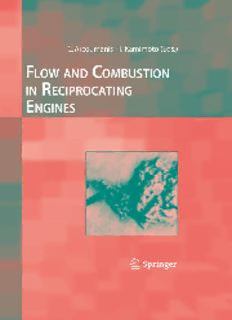Table Of ContentExperimental Fluid Mechanics
SeriesEditors
Prof.R.J.Adrian Prof.M.Gharib
Dept.ofMechanicalandAerospace CaliforniaInstituteofTechnology
Engineering GraduateAeronauticalLaboratories
ECG346 1200E.CaliforniaBlvd.
P.O.Box876106 MC205-45
Tempe,AZ85287-6106 Pasadena,CA91125
USA USA
Prof.Dr.W.Merzkirch Prof.Dr.D.Rockwell
Universita¨tEssen LehighUniversity
Lehrstuhlfu¨rStro¨mungslehre Dept.ofMechanicalEngineeringandMechanics
Schu¨tzenbahn70 PackardLab.
45141Essen 19MemorialDriveWest
Germany Bethlehem,PA18015-3085
USA
Prof.J.H.Whitelaw
ImperialCollege
Dept.ofMechanicalEngineering
ExhibitionRoad
LondonSW72BX
UK
·
C. Arcoumanis T. Kamimoto
Editors
Flow and Combustion
in Reciprocating Engines
123
Prof.C.Arcoumanis Prof.T.Kamimoto
CityUniversityLondon TokaiUniversity
SchoolofEngineering& Dept.ofMechanicalEngineering
MathematicalSciences 1117Kitakaname
NorthamptonSquare Hiratsuka-shi,Kanagawa
LondonEC1V0HB Japan
UnitedKingdom [email protected]
[email protected]
ISBN:978-3-540-64142-1 e-ISBN:978-3-540-68901-0
LibraryofCongressControlNumber:2008926729
(cid:2)c 2009 Springer-VerlagBerlinHeidelberg
Thisworkissubjecttocopyright.Allrightsarereserved,whetherthewholeorpartofthematerialis
concerned,specificallytherightsoftranslation,reprinting,reuseofillustrations,recitation,broadcasting,
reproductiononmicrofilmorinanyotherway,andstorageindatabanks.Duplicationofthispublication
orpartsthereofispermittedonlyundertheprovisionsoftheGermanCopyrightLawofSeptember9,
1965,initscurrentversion,andpermissionforusemustalwaysbeobtainedfromSpringer.Violationsare
liabletoprosecutionundertheGermanCopyrightLaw.
Theuseofgeneraldescriptivenames,registerednames,trademarks,etc.inthispublicationdoesnotimply,
evenintheabsenceofaspecificstatement,thatsuchnamesareexemptfromtherelevantprotectivelaws
andregulationsandthereforefreeforgeneraluse.
Coverdesign:WMXDesignGmbH,Heidelberg
Printedonacid-freepaper
9 8 7 6 5 4 3 2 1
springer.com
Introduction
Theinternalcombustionenginefuelledbymainlygasolineanddieselhasbeenthe
dominantpowerplantforwellover100years.Althoughthecontinuationofitsdom-
inanceworldwidehasbeenquestionedbyenvironmentalists,whoseecarsthreaten-
ingtheplanet’sclimatethroughtheeffectofCO onglobalwarming,andbysome
2
engineers who have been overoptimistic about the potential, and the timing of in-
troductionoffuelcellsandelectricvehiclesintomassproduction,thereciprocating
engine is here to stay for the foreseeable future. The key to its success has been
its continuous re-invention into more efficient and cleaner modes of combustion,
theon-goingdevelopmentandrefinementofcatalyticconvertersandthesuccessful
partnershipbetweenengines,transmissionsandelectricsystems.Anotherinterest-
ing development is the different approach of automotive engineers in the various
continents;forexample,Europeanshaveconsistentlyputmorefaithintodieselen-
gines,withover50%ofnewcarsinEuropebeingdiesels,whileJapanandtheUS
havefaithfullysupportedtherelativelylessefficientgasolineenginesand,morere-
cently, gasoline-hybrid vehicles which represent a reasonable compromise. There
arealsootherswhobelievethatthetimehascomeforaconvergenceintheglobal
markets through the introduction of the diesel hybrid vehicle but there are uncer-
taintiesaboutitsabilitytoacquire‘massproduction’statusbeforefuelcellpowered
andelectricvehiclesbecomeaffordablebycustomersworldwide.
This volume attempts to bridge a serious gap in the existing literature between
conventionaltextbookssuchasthehighlysuccessfuloneauthoredbyJohnHeywood
in 1987 and the significant technological breakthroughs presented in worldwide
conferences during the last ten years on direct-injection gasoline engines, ad-
vanceddieselsandhomogeneous-chargecompression-ignitionengines.Themulti-
authoredvolumeconsistsofeightchapterswrittenbyworldexpertsfromindustry,
governmentlaboratoriesandacademia.Eachofthechaptersisself-containedand,
therefore, independent from the others in that it covers its central theme in depth,
andwidth,althoughpriorknowledgeofthefundamentalsremainsaprerequisite.As
suchitisexpectedthatthisvolumewillbecomeanessentialreferencetextofengi-
neers involved in research and development in global automotive and consultancy
companies,researchengineersingovernmentlaboratoriesandacademicresearchers
v
vi Introduction
involvedinfundamentalandappliedresearchonvariousaspectsoftheflow,mixture
preparationandcombustioninreciprocatingengines.
Chapter1considersthefundamentalsofspark-ignition,combustionandemis-
sionsinconventionalportfuelinjectionengineswhichareintermsofnumbersthe
preferred powerplant worldwide. Emphasis is placed on the characteristics of the
ignitionsystem,themodelingofpremixedturbulentcombustion,initiationandde-
velopmentofknockandthepollutantformationmechanisms.
Chapter2describesingreatdetailtheresearchperformedoveraperiodofmore
thantenyearsondirect-injection,two-strokegasolineengineswhich,despitetheir
obviouspromise,neverreachedproductionintheautomotivemarket.Thischapter
also provides detailed information about the various optical diagnostic techniques
widely used in the research laboratories of all major automotive companies and
universitieswhich,togetherwithcomputationalfluiddynamic(CFD)models,have
become standard engineering tools in R&D. Although there are no two-stroke au-
tomotive engines driving road vehicles today, the research approach described in
Chap.2hasbeeninstrumentalinthedevelopmentofthefour-strokedirectinjection
engineswhichappearedinthemarketinthelate1990s.
Chapter 3 presents in its first part an overview of the general features of the
first-generationfour-strokeDIengines,theiradvantagesaswellastheirlimitations,
whilethesecondpartfocusesonmorerecentresearchonthesecond-generationof
stratifiedDIengineswhichareenteringproductionequippedwiththelatesttechnol-
ogyofhigh-pressuregasolineinjectors.Detailsareprovidedaboutbothmulti-hole
and pintle injectors operating in the spray-guided concept, and their potential for
becoming standard technology is discussed in both naturally-aspirated and super-
charged/turbochargedengineconfigurations.
Chapter4describestheflowfieldindirect-injectiondieselenginesoperatingin
thepresenceofswirl,whereparticularemphasisisplacedonthemeanandturbulent
flow structure around top-dead-center (TDC) of compression as characterised by
bothlaser-based-experimentsandCFDpredictions.Theimplicationsofsquishand
swirl,aswellasfuelinjectiononcombustionarealsodescribedanddiscussed.
Chapter5providesacomprehensiveanalysisofthepenetrationofdieselfuels,
spraysandjetsunderquiescentconditions,inordertoavoidtheimplicationofswirl
andmeanflow-structureonspraydevelopment,thesubsequentflameinitiationand
lift-off, as well as the link between mixing-controlled fuel-vaporisation, and com-
bustionunderdiesel-enginethermodynamicconditions.
Chapter6complementstheprevioustwochaptersbyfocusingonauto-ignition,
combustion and soot and NOx emissions in conventional diesel engines. Empha-
sisisplacedonthefactorsaffectingauto-ignition,itsmodelingapproach,thesoot
formationandoxidationmechanisms,aswellasthepracticalmeansforcontrolling
combustioninsecond-generationdirect-injectiondieselengines.
Chapter 7 presents an overview of the various types of advanced diesel com-
bustionwhich,atpresent,arethesubjectofintenseinvestigationbyresearchersin
bothindustryandacademia.AlthoughHCCI(homogeneouschargecompressionig-
nition)isthemostwell-knownformofadvancedcombustion,itiswidelyaccepted
thatpremixed, controlled-autoignition, low-temperature combustion representsthe
Introduction vii
most promising concept for eliminating both NOx and soot emissions in the next
generationofdieselengines.
Finally, Chapter 8 summarises in the first part the fuel effects on combustion
andemissionsforpetroleum-basedhydrocarbonfuels(gasolineanddiesel)whilein
thesecondparttheemphasisisplacedonalternativeandrenewablefuels,including
syntheticfuels,thatofferpromisetobeusedinreciprocatingengines.
March2008 DinosArcoumanis
TakeKamimoto
Contents
1 SparkIgnitionandCombustioninFour-StrokeGasolineEngines..... 1
RudolfR.MalyandRu¨digerHerweg
2 Flow, Mixture Preparation and Combustion in Direct-Injection
Two-StrokeGasolineEngines..................................... 67
ToddD.FanslerandMichaelC.Drake
3 Flow, Mixture Preparation and Combustion in Four-Stroke
Direct-InjectionGasolineEngines.................................137
HiromitsuAndoandConstantine(Dinos)Arcoumanis
4 Turbulent Flow Structure in Direct-Injection, Swirl-Supported
DieselEngines ..................................................173
PaulC.Miles
5 RecentDevelopmentsonDieselFuelJetsUnderQuiescentConditions.257
DennisL.Siebers
6 ConventionalDieselCombustion..................................309
MakotoIkegamiandTakeyukiKamimoto
7 AdvancedDieselCombustion.....................................353
KatsuyukiOhsawaandTakeyukiKamimoto
8 FuelEffectsonEngineCombustionandEmissions..................381
ThomasRyanandRudolfR.Maly
ix
Chapter 1
Spark Ignition and Combustion in Four-Stroke
Gasoline Engines
RudolfR.MalyandRu¨digerHerweg
1.1 Introduction
Today, and even more so in the future, significant and simultaneous reductions of
emissionsandfuelconsumptionarethekeyissuesinenginecombustion.Sincethe
S.I.engineishighlydevelopedalready,commontrialanderrormethodsalonewill
nolongerbeadequatetomeetfuturerequirements.Fuelandenginepropertiesform
suchacomplexsystemofmutuallyinteractingprocessesthatadetailedknowledge
ofallitspropertiesisrequiredifpossibleimprovementsshallbesuccessfullyiden-
tified, implemented and optimized. Therefore, a close link between practical and
theoretical work is mandatory right from the start of conceiving new combustion
concepts. New ideas must be complemented with adequate diagnostics to assess
benefitsordrawbacksandalsowithmodels,preferablypredictiveones,forguiding
andmonitoringprogress.
Thischapterpresentsanoverviewonwherewearetodayandidentifieswhatwe
willneedforfutureS.I.enginecombustionrequiringknowledgebothfrompractical
engine work and from fundamental combustion studies. Since there is a wealth of
informationavailableinbothareasitwillbeimpossibletocoveralldetailsexplicitly,
andtherefore,emphasisisplacedonmaintraits.Citationswillbemadepreferablyto
review-typepublicationswhenever possiblefacilitatingtracingbacktoolderwork
andretrievingadditionalindepthinformationifrequired.Recommendedsourcesfor
review-typeliteratureare:Heywood’stextbook[1],thejournal:ProgressinEnergy
and Combustion Science, the proceedings of the Symposia (Int.) on Combustion
andtheproceedingsoftheinternationalsymposiaonDiagnosticsandModelingof
Combustionininternalcombustionengines(COMODIA).Thepaperfocusesonthe
morefundamentalaspectssinceathoroughunderstandingoftheunderlyingphysics
RudolfR.Maly
Consultant Engines and Future Fuels, formerly Daimler AG, Research Division, 71065
Sindelfingen,Germany,e-mail:[email protected]
Ru¨digerHerweg
WorkcarriedoutatInstitutfu¨rPhysikalischeElektronik,UniversityofStuttgart,Germany,
e-mail:rue [email protected]
C.Arcoumanis,T.Kamimoto(eds.),FlowandCombustioninReciprocatingEngines, 1
DOI:10.1007/978-3-540-68901-0 1,(cid:2)C Springer-VerlagBerlinHeidelberg2008
Description:Berlin, Heidelberg: Springer-Verlag, 2009. 420 р.ContentsSpark Ignition and Combustion in Four-Stroke Gasoline Engines Rudolf R. Maly and Ruediger Herweg Flow, Mixture Preparation and Combustion in Direct-Injection Two-Stroke Gasoline Engines Todd D. Fansler and Michael C. DrakeFlow, Mixture Prepar

